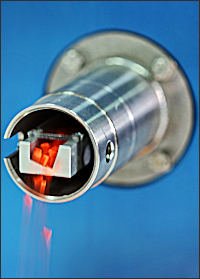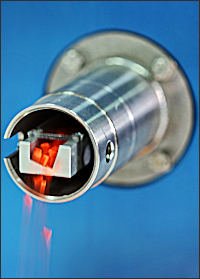Small Dosage Gravimetric Feeders
For plastics manufacturers producing small and micro sized products, those working with highly expensive additives, and in other applications where high precision dosing small quantities of additives is required, a question has been raised if it is possible to obtain greater accuracy and precision from loss in weight gravimetric feeders.
This white paper examines the technology of a new small dose gravimetric feeder that obtains consistent high dosing resolution – even when working with extremely small quantities of additives.
Loss in weight gravimetric and volumetric feeders for plastics additives, with their assortment of screws have become a standard in plastics manufacturing, as they lower masterbatch inventory costs and provide greater processing flexibility. Typically, screw feeders have a very hard time dosing according to weight when the job requires very small quantities of additives. During extrusion, screw feeders will start experiencing problems in accurate dosing when the dosing rate is under 200 grams/hour.
The question that this paper seeks to answer, in applications where accuracy beyond the capabilities of existing screw feeders are required, i.e., when producing small and micro sized products or semi-transparent pieces, what technology is available for near-absolute dosing resolution.
Considering that an incorrect ratio of additive to virgin resin results in inconsistent coloring or product rejects, injection molding and extrusion manufacturers potentially have a lot to gain.
A Small Dose Gravimetric Feeder Example
Gravimetric Feeders White Paper On Highly Accurate Gravimetric Feeding for Small Doses of Plastics Additives, Sponsored by LIAD
For plastics manufacturers producing small and micro sized products, those working with highly expensive additives, and in other applications where high precision dosing small quantities of additives is required, a question has been raised if it is possible to obtain greater accuracy and precision from loss in weight gravimetric feeders.
This white paper examines the technology of a new small dose gravimetric feeder that obtains consistent high dosing resolution – even when working with extremely small quantities of additives.
Loss in weight gravimetric and volumetric feeders for plastics additives, with their assortment of screws have become a standard in plastics manufacturing, as they lower masterbatch inventory costs and provide greater processing flexibility. Typically, screw feeders have a very hard time dosing according to weight when the job requires very small quantities of additives. During extrusion, screw feeders will start experiencing problems in accurate dosing when the dosing rate is under 200 grams/hour.
The question that this paper seeks to answer, in applications where accuracy beyond the capabilities of existing screw feeders are required, i.e., when producing small and micro sized products or semi-transparent pieces, what technology is available for near-absolute dosing resolution.
Considering that an incorrect ratio of additive to virgin resin results in inconsistent coloring or product rejects, injection molding and extrusion manufacturers potentially have a lot to gain.
A Small Dose Gravimetric Feeder Example
One plastics auxiliary equipment manufacturer, the original inventor of the single channel gravimetric masterbatch feeder for injection molding, introduced a new gravimetric feeder, with a novel vibrating channel and loss in-weight algorithms for accurately dosing small quantities of masterbatch and other additives. A new (patented) gravimetric feeder is ideal for small and micro sized products. Further, with its 550 Cc hopper and up to 80g/minute output range, the gravimetric feeder is capable of accurate dosing for most product sizes when used in conjunction with an optional Venturi loader.
With weighing accuracy and dosing resolution that can reach to within a single pellet, the new small dose gravimetric feeder offers factories real workplace advantages over traditional gravimetric feeding systems.
Furthermore, due to its unique design and single vibrating channel this example plastics additive feeder is capable of handling large and small additive feed rates without having to change screws or other parts. Regardless of pellet consistency, size or weight, or how many products are produced on the line, this new type of gravimetric feeder, with its single vibrating channel, offers a new level of additive feeding accuracy and efficiency.
Example Application
A Vibrating Gravimetric Feeder
Traditional loss in weight gravimetric feeders are screw fed, which depending on size of screw, speed of the rotation, and weight of the material, will dictate how much color or masterbatch additive will be distributed into the flow of virgin resin via the throat of the processing machine.
This example of small dosing feed technology enables small product manufacturers relief from manual mixing, difficult calibration, product rejects and over-consumption of masterbatch additive
The micro dosing resolution of the new gravimetric feeder is obtained by having a single vibrating channel which advances the additives to the inlet of the processing machine.
The feeding channel of this example of a new vibrating feeder is uniquely designed,lining up the pellets as they advance, and then controlling the rate of additive movement via electromagnetic pulses. Loss in weight analysis via advanced algorithms speeds up or lower the rate of the vibrations as necessary – a significant advancement over step motors alone or conveyor systems, which until now have not delivered high dosing control.
Calibration & Maintenance
Regardless of granule size, weight or physical properties, the gravimetric feeder offers consistent accuracy, while simultaneously eliminating some tasks associated with calibration and maintenance.
Furthermore, as the single vibrating channel is used for all jobs, calibration can be easilyperformed via the control panel, which monitors loss in weight that is determined from cycle to cycle. The set value is calculated from the specified shot weight, and the percentage of masterbatch or additive. This also means there is no machine down time for switching parts, with sterilization requiring less than a minute by taking the vibrating chamber out of the protective container, and air blowing all material.
With this setup, the new plastics additive gravimetric feeder can accurately and consistently dispense single or multiple pellets per batch.
Product rejects as a result of an aberration in masterbatch additive can occur in any sized product, but generally means that not enough additive was added to the resin. Yet as the product becomes smaller, or in other applications like semi-transparents where the additive dose needs to be very precise, the likelihood of a reject increases. (As gravimetric feeders naturally vary from the set point, the likelihood of a small product reject can easily reach 5%-10% according to some manufacturers, and possibly even higher as the product size becomes smaller.)
For this reason, some producers of small products will over compensate the additive, or in certain applications, even manually mix the additive with the resin.
As the owner of TAV Medical, a plastics producer which contracts for some of the world’s largest medical device manufacturers said, “It’s unbelievable that I am saying this at this time, but until now I have not found a solution for small product dosing. The simple truth is that when processing small jobs, no gravimetric or volumetric feeder was able to provide me with piece of mind in terms of efficiency, accuracy and consistency.”
With its vibrating channel and unique design, the new feeder consistently dispenses the required dose, effectively solving the problem of dose variation.
Weighing Specialty Additives
Specialty additives such as flame retardants or anti-microbial additives can be expensive, potentially reaching hundreds of dollars per kilo. And with every unnecessary pellet added to the injection mold, producers are literally throwing away money.
The producer of the new gravimetric feeder has over 30 years expertise in weighing applications, and has designed the new additive feeder with a level of accuracy not found in alternative small dose feeders.
To obtain better weighing accuracy and greater additive control, the company designed the vibrating chamber from a unique, light-weight material. This design offers multiple benefits, as it significantly improves the accuracy of the weighing chamber.
New Equipment Sales Channels
About the White Paper’s Sponsor: LIAD
LIAD Weighing and Control Systems, a veteran engineering company with over 35 years’ experience in the plastics industry, is recognized for innovative products which significantly improve plant efficiency, and innovative techniques for dosing masterbatch and color additives in particular. LIAD was the first company to introduce a number of auxiliary products for plastics manufacturing which are today considered standard, including a gravimetric feeder adjacent to the injection molding for precise measuring of color pellets.
In addition to ColorSave-Micro, LIAD is now introducing other innovative auxiliary equipment for injection molding and extrusion which promise to further increase efficiency and generate greater factory profit.
* BlendSave™ – A high-precision automated multi-channel weighing system for combining selected mixtures of masterbatches. The system reaches accuracy to within .03 grams per weighing channel.
* MultiSave™ – An automated multi-channel weighing and blending system capable of simultaneously feeding as many as 24 separate processing lines, while significantly reducing the amount of hoppers, blenders and required floor space.
* SpectroSave™ – A differential spectrometer used at the extrusion line for color quality control.





